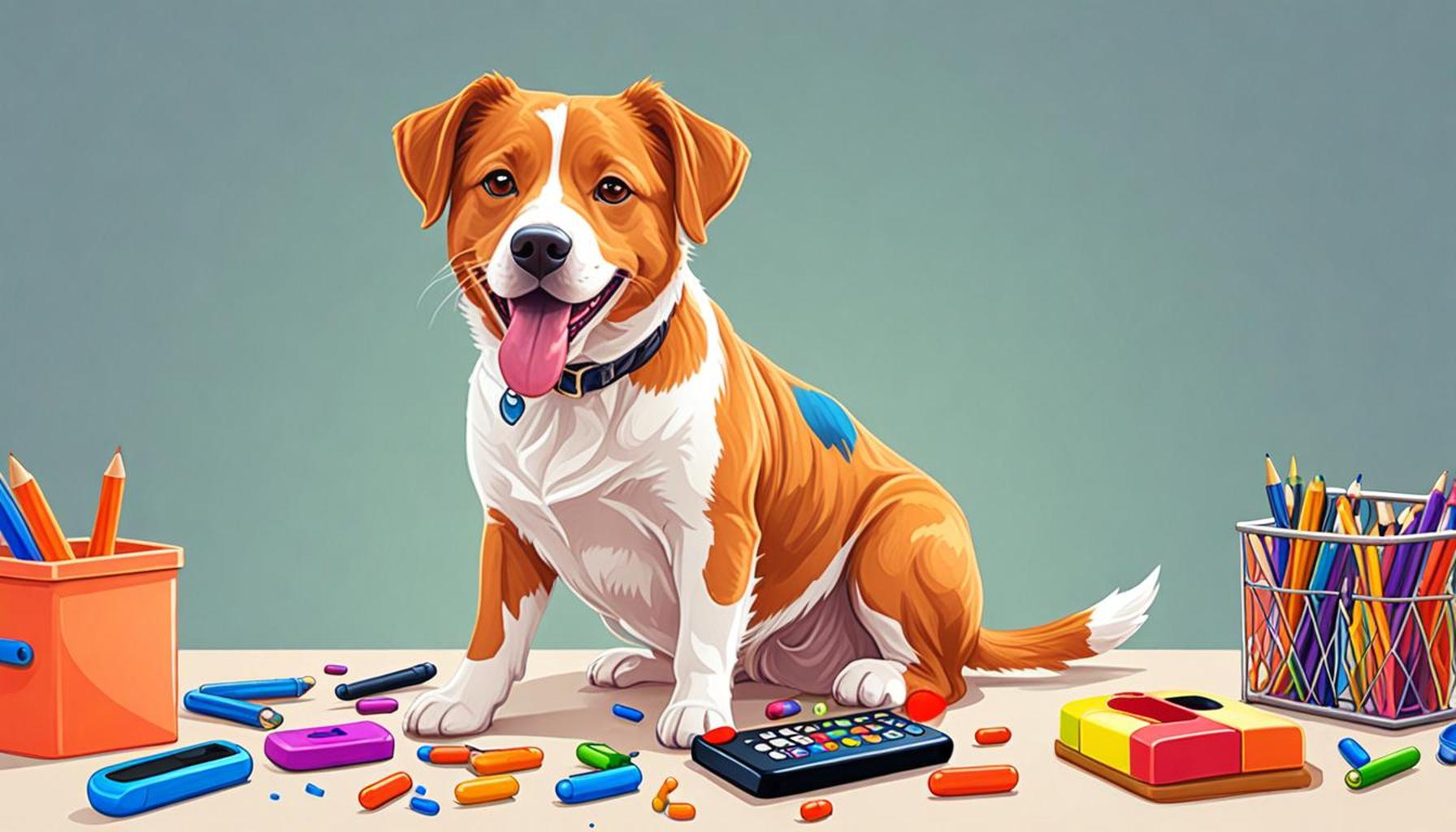Using Clicker Training to Improve Communication with Your Pet

Enhancing the Bond with Your Pet
Imagine transforming your relationship with your pet into a harmonious partnership. Clicker training offers a unique and effective way to communicate, paving the way for understanding and cooperation. This method, rooted in positive reinforcement, provides clear signals that can enhance your pet’s learning experience.
What is Clicker Training?
Clicker training utilizes a simple handheld device that makes a distinct sound—a “click.” This sound acts as a marker for your pet, indicating that they performed a desired behavior. Here’s why it stands out:
- Clarity: The click sound provides clear feedback. This distinct sound marks the precise moment your pet exhibits the desired behavior, making it clear what action is being rewarded.
- Consistency: It helps maintain consistent communication. Every click means a reward is forthcoming, which helps your pet learn that certain actions will bring positive outcomes.
- Positive Reinforcement: Encourages desired behaviors without force. Instead of punishment or negative reinforcement, clicker training focuses on celebrating successes, fostering a positive learning environment.
Benefits of Using Clicker Training
Many pet owners are discovering the advantages of this method. The benefits extend beyond mere obedience training, creating deeper connections between you and your pet. These advantages include:
- Improved Communication: Clicker training enhances understanding between you and your pet. Through this method, pets can learn to interpret human cues better, bridging the communication gap that often exists.
- Stronger Bond: Building trust through positive reinforcement is one of the most rewarding aspects of this training technique. Pets become more confident and secure when they realize that their efforts are valued and recognized.
- Versatile Learning: This training method works for various animals, including dogs, cats, and even birds. Clicker training is adaptable, allowing you to teach a wide range of commands—from basic sit and stay to more complex tricks like roll over or fetch.
Clicker training fosters a stimulating environment that not only teaches practical skills but also contributes to your pet’s overall happiness and well-being. For example, many trainers encourage teaching tricks such as high-five or spin, which not only stimulate your pet mentally but also strengthen the bond you share during the learning process.
Unlock the potential of your pet’s abilities and create a rewarding bonding experience through the power of clicker training. Many resources are available to help you get started, including online tutorials, training classes, or even books specifically focused on this method. Dive deeper into this fascinating approach and see how it can transform your interactions and elevate your connection with your beloved pet.
DIVE DEEPER: Click here to discover local pet adoption resources
Understanding the Clicker Training Process
To embark on your journey with clicker training, it’s crucial to grasp the fundamental steps involved in this technique. While beginner pet owners might feel daunted by the idea of training their furry companions, the simplicity of clicker training often surprises them. Let’s break down the basic components that make this method effective and accessible for everyone.
Getting Started with Clicker Training
The first step in clicker training is selecting an appropriate clicker device. These devices come in various forms, from traditional handheld clickers to smartphone apps that mimic the sound. Whichever option you choose, ensure that it produces a sound that captures your pet’s attention. After you obtain a clicker, it’s essential to condition your pet to associate the click sound with a reward.
This can be accomplished through a simple process known as *charging the clicker*. Here’s how to do it:
- Click and Treat: Start by clicking the device and immediately giving your pet a treat. It’s important to do this in quick succession so your pet begins to understand that the click signifies a reward.
- Repeat Repeatedly: Continue this repetition multiple times until your pet shows excitement or anticipatory behavior when they hear the click.
- Introduce Commands: Once conditioned, introduce a command or action right before you click. For instance, say “sit,” and when your pet sits, click and reward them. This sequence will cement the connection between the behavior and the reward in your pet’s mind.
Choosing the Right Environment
Creating an ideal training environment is another critical element of successful clicker training. A quiet space free from distractions will help your pet focus on the task at hand. Consider the following tips:
- Minimize Distractions: Begin in a familiar setting, such as your living room or backyard, where external stimuli, like other animals or loud noises, are limited.
- Short Sessions: Keep training sessions brief, around 5 to 10 minutes, to maintain your pet’s interest and prevent fatigue.
- Consistency is Key: Use the same commands and cues consistently. The more predictable your signals are, the easier it will be for your pet to learn and respond accordingly.
The beauty of clicker training lies not only in its effectiveness but also in the joy it brings to both pet and owner during the learning process. By using positive reinforcement, you’re not only teaching your pet commands but also building their confidence, making them more eager to engage in future training sessions. Remember, every pet learns at their own pace; patience and positivity are your best allies on this training journey.
As you delve deeper into clicker training, you will find that it can be an enriching experience for both you and your pet, enhancing communication and strengthening your bond like never before. With each click, you’ll discover new ways to express your understanding, patience, and love, ultimately transforming your relationship into a cohesive partnership.
| Advantage | Details |
|---|---|
| Clear Communication | Clicker training fosters a clear and consistent method for pets to understand commands and expectations. |
| Positive Reinforcement | This technique emphasizes positive reinforcement, helping to build trust and strengthening the bond between pet and owner. |
The integration of clicker training in communication enhances the ability to convey messages to pets effectively. This training method utilizes a distinct sound to mark desired behaviors, which leads to a more obedient and understanding animal. By offering immediate feedback, pet owners can ensure that their companions associate the click sound with positive actions, reinforcing learning. Furthermore, this method promotes a playful atmosphere where learning becomes a fun activity for both the pet and owner. It’s scientifically backed that animals trained in a positive environment tend to perform tasks more efficiently and display enhanced behavioral improvements. Engaging with your pet through clicker training not only advances communication but also transforms the learning experience into a shared adventure.
DISCOVER MORE: Click here to find local pet adoption resources
Enhancing Your Communication Skills Through Clicker Training
As you continue your journey with clicker training, it’s essential to recognize how this method not only benefits your pet but also enhances your communication skills as an owner. Clicker training revolves around the principles of clear cues and immediate feedback, creating a foundation for effective communication between you and your pet. This process fosters an understanding of non-verbal signals and encourages mutual respect, allowing both the pet and the owner to express themselves fully.
Understanding Your Pet’s Body Language
Part of improving communication with your pet through clicker training involves being aware of their body language. Each pet has a unique way of expressing their feelings, and clicker training encourages owners to pay attention to these signals. Recognizing how your pet responds to different commands and rewards will help you tailor your training approach effectively. Here are a few common body language signals to observe:
- Tail Position: A high wagging tail typically indicates excitement or happiness, while a tucked tail might suggest insecurity or fear.
- Ear Position: Forward-facing ears usually signal curiosity, while flattened ears may indicate distress or discomfort.
- Posture: An open, relaxed posture shows confidence and comfort, while a crouched or stiff posture may reveal anxiety or tension.
Being attuned to these signals enhances your ability to communicate effectively, ensuring that your training sessions are enjoyable and productive for both you and your pet.
Feedback and Reinforcement: Creating a Positive Learning Atmosphere
Clicker training significantly enhances the feedback loop in training. The immediate sound of the clicker following a desired behavior not only confirms the action but also builds excitement for the next command or task. Research shows that positive reinforcement techniques, like those used in clicker training, improve retention rates. According to a survey from the American Kennel Club, over 80% of pet owners who utilize clicker training report faster learning and stronger bonds with their pets. This is primarily due to the continuous encouragement that motivates pets to engage more actively during training sessions.
Incorporating variety into your training sessions through different commands, tricks, and activities also adds an element of fun and challenge. For example, teaching commands like “high five” or “spin” can stimulate your pet’s mind while making the training process enjoyable. Use the clicker to reinforce not only basic commands but also more complex tricks that require problem-solving skills, thereby enriching your pet’s mental capacity and expanding your communication repertoire.
Building Trust and Respect
Trust and respect form the backbone of successful communication, and clicker training is a powerful tool to cultivate these elements in your relationship with your pet. By utilizing clicker training, you demonstrate to your pet that they can rely on you for consistent guidance, which fosters a sense of security. This bond translates into better compliance during training sessions, as pets learn to anticipate their owners’ expectations with clarity and confidence.
Real-life examples illustrate the powerful impact of clicker training on trust-building. Many dog owners recount how their once-aloof dogs transformed into loving companions through the relationship nurtured within clicker training sessions. Similarly, cat owners have seen a noticeable shift in their feline friends, with greater willingness to engage during training and playtime. These stories emphasize the potential for improved communication through mutual respect and understanding.
Ultimately, the journey of clicker training serves as a pathway to not only teach commands but also to develop a deeper bond with your pet. As you and your furry friend navigate this learning experience together, you’ll find that the benefits extend far beyond mere obedience, positively influencing your communication and relationship overall.
LEARN MORE: Click here to discover the essentials of pet nutrition
Conclusion: The Lasting Impact of Clicker Training on Pet Communication
In summary, clicker training is not only an effective method for teaching your pet new behaviors but also a powerful tool for enhancing communication between you and your furry companion. Through positive reinforcement and immediate feedback, both you and your pet can develop a mutual understanding that deepens your bond. As you engage with your pet in training sessions, you’ll find that their body language and cues become increasingly apparent, allowing for clearer interactions.
Moreover, the act of clicker training fosters an environment of trust and respect, which is crucial for successful pet ownership. By consistently applying this method, you create a foundation where your pet feels secure enough to express themselves, and in turn, you learn to interpret their signals better. Owners who embrace clicker training report not just improved obedience from their pets, but enhanced emotional connections, leading to more fulfilling relationships.
As you embark on or continue your journey with clicker training, remember that the skills you develop extend beyond classroom-like settings. Incorporating this positive reinforcement strategy into daily interactions can further elevate the quality of communication with your pet. So, take the plunge, click that clicker, and watch as your pet transforms—one rewarding moment at a time. Explore various resources and communities dedicated to clicker training to continue growth and ensure enjoyable experiences for both you and your beloved animal.
Ultimately, the rewarding experience of clicker training can pave the way for a lifetime of understanding and joy. By investing time and patience now, you lay the groundwork for a lasting, enriching partnership with your pet.



